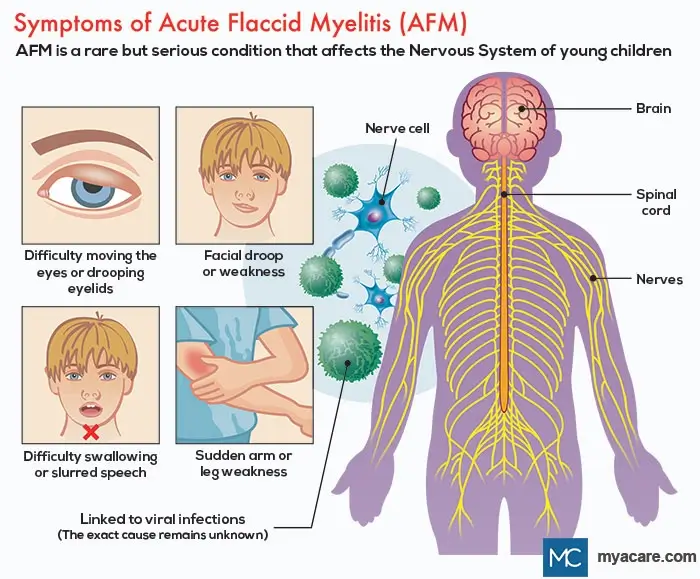Acute Flaccid Myelitis: A Polio-Like Illness Parents Should Know About

Medically Reviewed by Dr. Sony Sherpa, (MBBS) - October 1, 2024
As a parent, it can be terrifying to see your child suddenly experience muscle weakness or paralysis. Unfortunately, this is the reality for many families who have children diagnosed with Acute Flaccid Myelitis (AFM). If left untreated, this rare but severe condition that affects the spinal cord can cause irreversible damage.
In this article, we will discuss what AFM is, its symptoms, treatment, and why it is important for parents to be aware of this condition.
What Is Acute Flaccid Myelitis?
Acute Flaccid Myelitis (AFM) is a rare neurological condition that affects the spinal cord, causing sudden muscle weakness or paralysis. It is often referred to as a "polio-like illness" because it shares some similarities with polio, a disease caused by the poliovirus, which also leads to muscle weakness and paralysis. However, AFM is not caused by the poliovirus and is a separate condition.
AFM affects the gray matter of the spinal cord, which is responsible for controlling muscle movement. When this area becomes inflamed, it can disrupt the signals between the brain and muscles, leading to muscle weakness or paralysis. In some cases, AFM can also affect the nerves that control breathing and swallowing, making it a life-threatening condition.
While causes have yet to be confirmed, AFM is very closely associated with viral illness.
Prevalence of Acute Flaccid Myelitis
It is difficult to know the prevalence of AFM, due to various factors, including lack of standardized diagnostics, potential underreporting, and limited data collection. Currently, the numbers are estimated to be very low, roughly approximating 1-15 people per million (these are higher in Afghanistan due to a lack of polio vaccine implementation). However, it is crucial to remember that AFM can occur even in highly vaccinated populations, although at lower frequencies.
Sporadic viral outbreaks are associated with AFM, with documented cases occurring in different parts of the world in limited numbers. Since its first identification in 2014, the Centers for Disease Control and Prevention (CDC) in the United States have reported an increase in AFM cases every two years, with peaks in late summer and early fall.[1] A very similar trend has been noted in Europe with regard to viral outbreaks that may promote AFM.[2]
Why was there no outbreak of AFM in 2020? The absence of an outbreak of AFM in 2020 is possibly due to the implementation of COVID-19 prevention measures, which likely reduced the transmission of AFM-associated viral transmissions. These measures could have helped identify and contain potential outbreaks before they become widespread.
Acute Flaccid Myelitis Symptoms
Sudden muscular weakness or paralysis, generally in one or more limbs, is the most prevalent symptom of AFM. This weakness can progress rapidly, sometimes within hours, and can affect both arms and legs.[3]
Another name for AFM muscle weakness is flaccidity, referring to hyporeflexia (non-responsiveness) of the affected limbs. Hence, the name Acute Flaccid Paralysis or Myelitis (myelitis is inflammation of the spinal cord).
Flaccidity is very often preceded by a fever or viral infection and is not often symmetrical when either side of the body is compared.
Other symptoms may include:
- Difficulty moving the eyes
- Drooping eyelids
- Difficulty swallowing or speaking
- Facial droop or weakness
- Slurred speech
- Difficulty breathing
- Loss of bladder or bowel control
- Headache
- Neck pain and stiffness
It is important to note that not all children with AFM will experience all of these symptoms. Some may only have muscle weakness, while others may have a combination of symptoms.
The symptoms are the worst in the initial phase of the disease, which can last days to weeks. After this phase, some improvements are noted (such as restored facial muscle responsiveness), yet residual muscle weakness and physical disability are often lifelong. Full recovery can be seen in up to 10% of cases.
Parents need to seek medical attention urgently if their child experiences any of these symptoms, especially if they occur suddenly.

Complications
The two main complications include respiratory failure or other life-threatening neurologic complications that interfere with temperature regulation, blood pressure, or heart function.
Acute Flaccid Myelitis Ages Affected
All age groups are susceptible to AFM, but it is most commonly seen in children. The average age of children diagnosed with AFM is 5 years old, but cases have been reported in children as young as 6 months and as old as 17 years.
It is important for parents to be aware of this condition and its symptoms, as early detection and treatment can greatly improve outcomes.
While AFM primarily affects children, it can also occur in adults. If you suspect that you or someone you know may have AFM, it is important to seek medical attention promptly for a proper diagnosis and treatment.
AFM vs. Transverse Myelitis
Acute Flaccid Myelitis (AFM) and transverse myelitis are two different conditions that have some similarities. Transverse myelitis is also a rare neurological condition that involves inflammation of the spinal cord. It can cause sensory disturbances, muscle weakness, and paralysis. It is thought to have very similar causes to AFM, such as viral infections, autoimmune disorders, and spinal cord injuries. Transverse myelitis is more commonly seen in adults.[4]
What is the Difference Between Acute Flaccid Myelitis and Guillain-Barré Syndrome?
Acute Flaccid Myelitis (AFM) and Guillain-Barré Syndrome (GBS) are both neurological conditions that can cause muscle weakness and paralysis. However, there are some key differences between the two.
A bacterial or viral infection, like Campylobacter jejuni or the Zika virus, usually sets off an immunological reaction that results in GBS. It affects people of all ages equally, including children and adults. Unlike AFM, which only affects the spinal cord, GBS primarily affects the peripheral nerves outside of the spinal cord. The weakness or paralysis in GBS starts from the legs and spreads to the upper body. GBS also has a more gradual onset than AFM, with symptoms worsening over the course of several days or weeks.
What Causes Acute Flaccid Myelitis?
While viral infections are thought to be involved, the exact cause of AFM is still unknown.
It is associated with a variety of viruses, including West Nile virus, adenoviruses, and enteroviruses, especially enterovirus D68. These viruses can cause inflammation and damage to spinal cord nerves that control movement, leading to the symptoms of AFM.[5]
Not all children who are exposed to viral infections will develop AFM, and the condition is still considered rare.
Some theories that suggest how viral infections may play a role in the development of the condition include:
- Immune Response: AFM may be triggered by an abnormal immune response to certain viral infections. These may cause the immune system to overreact and chronically attack the nerves in the spinal cord, leading to inflammation and damage.
- Genetic Susceptibility: Some studies suggest that genetic variation or gene mutations involved in immune function or nerve development may make some individuals more prone to developing AFM when exposed to viral infections.
It is important to note that while these theories provide some insight into the possible mechanisms of AFM, they are not yet fully confirmed. Further research is needed to uncover the exact mechanisms behind this condition.
How Is Acute Flaccid Myelitis Diagnosed?
Diagnosing AFM can be challenging, as symptoms can be similar to other conditions, such as Transverse Myelitis. A thorough physical examination, along with a review of the child's medical history, is crucial in making a diagnosis. Doctors may also order imaging tests, such as an MRI, to look for inflammation or lesions in the spinal cord.[6]
A spinal tap may be necessary in some circumstances to obtain a sample of cerebrospinal fluid, which can then be examined for indications of inflammation or infection. This can help rule out other conditions and confirm a diagnosis of AFM.
Acute Flaccid Myelitis Treatment
Treatment options for AFM are limited, and early detection can greatly improve outcomes. Supportive care is the mainstay treatment for the initial phase, while nerve transfer surgery may be an option for treating long-term muscle weakness.[7]
Supportive care treatments include:
- Hospitalization for close monitoring
- Physical therapy to help strengthen muscles and improve mobility
- Occupational therapy to help with daily activities
- Speech therapy to help with swallowing and speaking difficulties
- Breathing support, such as a ventilator, if necessary
In some cases, doctors may also prescribe medications to help manage symptoms and prevent complications.
Nerve Transfer Surgery for AFM
In 2018, Dr. Amy Moore performed one of the world's first successful nerve transfer for AFM on an 8 year old boy, Brandon Noblitt. Prior to the procedure, Brandon was wheelchair-bound for two years after waking up one morning, unable to move out of bed. 14 months after the procedure, Brandon was walking normally again.
Nerve transfer surgery is a potential treatment option for patients with AFM. This surgical procedure involves taking healthy nerves from one part of the body and transferring them to the affected muscles to restore function.[8] It works better for children than adults because children's nerves are still growing at a rapid rate, which is conducive to regeneration and full recovery.
Since Brandon's success story, it has quickly become a standard treatment option for children with AFM. The effectiveness of nerve transfer surgery may vary from case to case, yet overall success rates have been rather high. It is important to consult with a healthcare professional who is experienced in AFM when considering a surgical route.
How Can Acute Flaccid Myelitis Be Prevented?
Since the exact cause of AFM is still unknown, there is no specific way to prevent it.[9] However, there are steps that parents can take to reduce their child's risk of developing AFM:
- To stop the spread of germs, wash your hands frequently
- Keep your child up to date on vaccinations, including the polio vaccine
- Refrain from getting too close to sick people
- Stay home if you or your child are feeling ill
- When sneezing or coughing, keep your mouth and nose covered
- Clean and disinfect frequently touched surfaces
Conclusion
Acute Flaccid Myelitis (AFM) is an uncommon but dangerous condition that affects the spinal cord and can lead to sudden muscle weakness or paralysis. It is important for parents to be aware of the symptoms of AFM and seek medical attention if their child experiences them. Early detection and treatment can greatly improve outcomes and prevent long-term complications. By staying informed and taking preventative measures, parents can help reduce their child's risk of developing AFM.
To search for the best Pediatric Neurology doctors and healthcare providers worldwide, please use the Mya Care Search engine.
To search for the best healthcare providers worldwide, please use the Mya Care search engine.
The Mya Care Editorial Team comprises medical doctors and qualified professionals with a background in healthcare, dedicated to delivering trustworthy, evidence-based health content.
Our team draws on authoritative sources, including systematic reviews published in top-tier medical journals, the latest academic and professional books by renowned experts, and official guidelines from authoritative global health organizations. This rigorous process ensures every article reflects current medical standards and is regularly updated to include the latest healthcare insights.

Dr. Sony Sherpa completed her MBBS at Guangzhou Medical University, China. She is a resident doctor, researcher, and medical writer who believes in the importance of accessible, quality healthcare for everyone. Her work in the healthcare field is focused on improving the well-being of individuals and communities, ensuring they receive the necessary care and support for a healthy and fulfilling life.
Sources:
Featured Blogs



